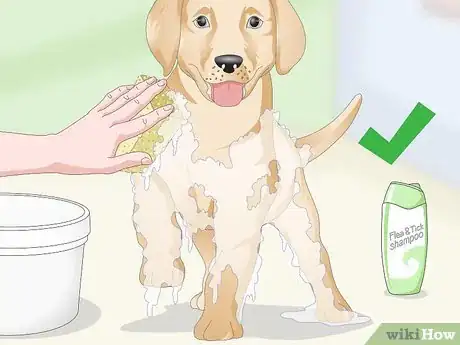This article was co-authored by Ray Spragley, DVM and by wikiHow staff writer, Megaera Lorenz, PhD. Dr. Ray Spragley is a Doctor of Veterinary Medicine and the Owner/Founder of Zen Dog Veterinary Care PLLC in New York. With experience in multiple institutions and private practices, Dr. Spragley’s specializations and interests include non-surgical management of cranial cruciate ligament tears, Intervertebral Disk Disease(IVDD), and pain management in osteoarthritis. Dr. Spragley holds a BS in Biology from SUNY Albany and has a Doctor of Veterinary Medicine degree (DVM) from Ross University School of Veterinary Medicine. He is also a Certified Canine Rehabilitation Therapist (CCRT) through the Canine Rehab Institute as well as a Certified Veterinary Acupuncturist (CVA) through Chi University.
There are 11 references cited in this article, which can be found at the bottom of the page.
wikiHow marks an article as reader-approved once it receives enough positive feedback. In this case, 100% of readers who voted found the article helpful, earning it our reader-approved status.
This article has been viewed 225,337 times.
Fleas are small, jumping insects that bite humans and other warm-blooded animals, such as dogs and cats, and drink their blood. Since fleas are small and quick, it’s often hard to spot them. If you suspect you’re being bitten by fleas, you can look at the bites themselves for clues about what might be causing them. If you have pets, they may also have tell-tale signs of flea bites. You can also keep an eye out for any actual fleas and their distinctive droppings (or “flea dirt”).
Steps
Identifying Flea Bites on a Human
-
1Check for bites on the legs and ankles. Fleas tend to bite humans on parts of the body that they can easily reach from the ground, such as the feet, ankles, and legs. They sometimes also bite in areas such as around the waistband (in the gap between the shirt and pants) or around the tops of your socks.[1]
- Due to the way fleas feed, their bites tend to occur in small clusters.
-
2Look for hard, red spots. Unlike other types of insect bites, flea bites don’t usually swell. Instead, the bites typically look like little red spots, sometimes with a light spot in the center.[2]
- You may be able to see a single puncture mark in the middle of the bite.
- Flea bites can sometimes bleed or scab over if you scratch them a lot.
Advertisement -
3Make note of itching or pain. One of the major symptoms of flea bites is intense itching, although some people may experience more itching than others. You might also find the bites painful.[3]
- If possible, try to avoid scratching the bites too much. Excessive scratching can cause the bites to become infected, and will also make the itching worse.
- Try relieving the itch with a topical cream, such as calamine lotion or an antihistamine cream.
-
4Watch for blisters if you’re sensitive to flea bites. If you’re allergic to flea bites, you may have a more severe reaction. In this case, the bites might swell and develop a blister at the center, which can eventually break and crust over.[4]
Warning: Severe allergic reactions from flea bites are rare. However, you should get immediate medical attention if you are bitten or stung by any insect and experience symptoms such as difficulty breathing, nausea or vomiting, or swelling of your face, mouth, lips, or tongue.[5]
-
5Keep an eye out for fleas. If you think you’re getting bitten by fleas, see if you can spot the fleas themselves. Fleas are small (about 1–3 millimetres (0.039–0.118 in) long, or a little smaller than a sesame seed), black or dark brown insects that typically jump. You may also see them wiggling through human hair or animal fur. They do not have wings.[6]
- You might find it easier to spot fleas on your feet or ankles if you’re wearing white or light-colored socks.
Spotting Flea Bites on a Pet
-
1Look for persistent scratching or biting behaviors. If your pet is being bitten by fleas, it will likely be intensely itchy. You may notice your dog or cat scratching itself constantly or biting and chewing on areas that it can’t reach with its claws.[7]
- An animal being harassed by fleas may also act jumpy or irritable.
-
2Check for rough, patchy, or thinning fur. If your pet is scratching and biting itself a lot, it may begin to damage or wear away its fur. Additionally, allergens in the fleas’ saliva can cause hair loss.[8] Check your pet for bald spots and rough or unusually dirty looking fur.[9]
- Cats with flea allergies often lose hair over large portions of their bodies, while dogs typically lose fur around the base of the tail.[10]
-
3Keep an eye out for scabs and sores on the skin. A flea-bitten pet may have obvious spots and scabs, especially in areas where they scratch or chew the most.[11] Look for sores and scabs in areas like the tail, rear end, legs, and neck.
- You might also notice general redness, irritation and inflammation, or areas where the skin is thickened or discolored.
- If your pet is allergic to fleas, they may develop sores that ooze or crust over.
Be aware: Irritated flea bites on a cat or dog can occasionally become infected. Look for signs of infection such as oozing sores with an unpleasant odor.
-
4Check your pets’ fur and bedding for flea dirt. Even if you never see the fleas themselves, they often leave behind tell-tale black flecks in your pet’s fur and bedding. Try running a comb through your animal’s fur to see if you can find flea dirt (feces) and live fleas.[12]
- Try combing your pet over a white surface, such as a piece of cloth or paper, so that any falling dirt or fleas are more obvious.
- To prevent the fleas from escaping and moving around your home, you can also comb your pet over a sink or tub with a little soapy water in it. This way, any fleas that you comb out of your pet’s fur will die when they land in the water.
- Since flea dirt is primarily composed of blood, it will turn red or reddish brown if you mix it with water.
- Focus on the parts of your animal where fleas are most likely to be active. For example, fleas most commonly gather on the ears, neck, lower back, and base of the tail on dogs.[13] On cats, fleas may concentrate on the back of the neck and top of the head.[14]
Preventing Flea Bites
-
1Keep your pets indoors if possible. If you’re being bitten by fleas, you most likely have an infested pet in your home. Pets such as dogs and cats can easily pick up fleas by going outside, so one of the best ways to keep fleas out of your home is to keep your pets indoors as much as possible.[15]
- If your pets do go outside, protect them from fleas by fitting them with flea collars or using regular spot-on flea prevention treatments.
- Some outdoor locations are more likely to have fleas than others. If you find that your pet keeps coming back from a specific park with a fresh flea infestation, try taking them to a different spot for a while and see if the situation improves.
-
2Treat any flea-infested pets promptly. If your pet does get fleas, treating them right away can reduce your chances of getting bitten. Comb your pet frequently to remove fleas and eggs from their fur, and treat them with a flea shampoo or another pet-safe insecticide treatment.[16]
- Flea treatments that are safe for one species of animal may not be safe for another.[17] For example, you should never treat a cat with any flea medication containing permethrin.[18]
- A few good treatment options include spot-on flea medications, such as Frontline and Advantage, or flea shampoos such as Adams Flea & Tick Shampoo.
- There are also a variety of fast-acting oral flea medications on the market, which are helpful for severe infestations. Some popular brands include Sentry Capguard and PetArmor Fastcaps.
- You can also purchase a flea collar to kill fleas on your pet and prevent future infestations. However, some flea collars may contain insecticides that are dangerous to pets and humans, such as tetrachlorvinphos, carbaryl, and propoxur.[19]
-
3Clean pet bedding areas regularly. Flea eggs, larvae, and pupae can accumulate in places where your pets regularly hang out and sleep. To prevent your pet from getting re-infested with fleas, vacuum their bedding and wash it on a long cycle with hot water.[20]
- If you can’t wash your pet’s bed, or if it’s thoroughly covered with flea dirt and dander, throw it out and replace it.
- It’s also a good idea to wash fabric pet toys and any surfaces where your pet likes to sleep, such as throw rugs or comforters.
- If your pet likes to sleep on your bed, wash your sheets and other bedclothes.
-
4Vacuum floors, rugs, and furniture. In addition to cleaning pet-specific areas, cleaning the rest of your house can also help get rid of flea eggs and pupae before they have a chance to hatch. Regularly vacuum your entire home, especially in areas where your pets tend to spend a lot of time.[21]
- After vacuuming, immediately empty the vacuum cleaner’s dirt chamber or remove the dust bag and throw it away outside your home.
-
5Try a house-wide insecticide treatment for severe infestations. If you have a major flea infestation in your home, your best bet may be to treat the whole house with an insecticide. You can either purchase an over-the-counter home flea treatment or call in a professional exterminator to handle the problem for you.[22]
- Flea treatments may come in the form of a spray or a “flea bomb” designed to spread the insecticide through your entire home.
- You may need to reapply the insecticide treatment after a couple of weeks to make sure you get any fleas that have hatched since the first treatment.
Warning: Check all safety information carefully before using a flea treatment in your home. You may need to board your pets outside the home during the flea treatment so that they won’t be exposed to potentially harmful chemicals.
Community Q&A
-
QuestionHow do you treat flea bites on humans?
 wikiHow Staff EditorThis answer was written by one of our trained team of researchers who validated it for accuracy and comprehensiveness.
wikiHow Staff EditorThis answer was written by one of our trained team of researchers who validated it for accuracy and comprehensiveness.
Staff Answer wikiHow Staff EditorStaff AnswerMost flea bites don’t require much treatment. Avoid scratching them, since this could irritate them or lead to an infection. Wash the bites with warm water and soap to help prevent an infection. You can also soothe any itching and inflammation with calamine lotion, antihistamine medications, or an ice pack. Talk to your doctor if you’re concerned that your bites are becoming infected (e.g., if you notice a rash around the bites, they are increasingly red or painful, or you see a discharge such as pus or a yellow crust on the bites).
wikiHow Staff EditorStaff AnswerMost flea bites don’t require much treatment. Avoid scratching them, since this could irritate them or lead to an infection. Wash the bites with warm water and soap to help prevent an infection. You can also soothe any itching and inflammation with calamine lotion, antihistamine medications, or an ice pack. Talk to your doctor if you’re concerned that your bites are becoming infected (e.g., if you notice a rash around the bites, they are increasingly red or painful, or you see a discharge such as pus or a yellow crust on the bites). -
QuestionHow do I check myself for fleas?
 wikiHow Staff EditorThis answer was written by one of our trained team of researchers who validated it for accuracy and comprehensiveness.
wikiHow Staff EditorThis answer was written by one of our trained team of researchers who validated it for accuracy and comprehensiveness.
Staff Answer wikiHow Staff EditorStaff AnswerFleas don’t usually “infest” humans, so you may only notice the bites on your ankles or other exposed areas. You might occasionally see a flea on your socks or hopping around on other parts of your body. You’re more likely to see fleas and flea dirt in your carpets, upholstery, or animal bedding.
wikiHow Staff EditorStaff AnswerFleas don’t usually “infest” humans, so you may only notice the bites on your ankles or other exposed areas. You might occasionally see a flea on your socks or hopping around on other parts of your body. You’re more likely to see fleas and flea dirt in your carpets, upholstery, or animal bedding. -
QuestionCan a human feel a flea bite?
 wikiHow Staff EditorThis answer was written by one of our trained team of researchers who validated it for accuracy and comprehensiveness.
wikiHow Staff EditorThis answer was written by one of our trained team of researchers who validated it for accuracy and comprehensiveness.
Staff Answer wikiHow Staff EditorStaff AnswerYou may feel a slight sting or a sudden itching sensation when the flea actually bites you. However, flea bites aren’t very painful, and it’s also possible that you won’t notice the bite until after the fact. Depending on how sensitive you are to flea bites, they may itch a lot, or you might hardly notice them at all.
wikiHow Staff EditorStaff AnswerYou may feel a slight sting or a sudden itching sensation when the flea actually bites you. However, flea bites aren’t very painful, and it’s also possible that you won’t notice the bite until after the fact. Depending on how sensitive you are to flea bites, they may itch a lot, or you might hardly notice them at all.
References
- ↑ https://www.dermnetnz.org/topics/flea-bite/
- ↑ https://extension2.missouri.edu/g7380
- ↑ https://www.dermnetnz.org/topics/flea-bite/
- ↑ https://www.dermnetnz.org/topics/flea-bite/
- ↑ https://www.medicalnewstoday.com/articles/311941.php
- ↑ https://www.dermnetnz.org/topics/flea-bite/
- ↑ https://extension2.missouri.edu/g7380
- ↑ https://extension2.missouri.edu/g7380
- ↑ https://www.rspca.org.uk/adviceandwelfare/pets/general/fleas
- ↑ http://www.vetstreet.com/care/flea-allergy-dermatitis-in-cats-and-dogs
- ↑ http://www.vetstreet.com/care/flea-allergy-dermatitis-in-cats-and-dogs
- ↑ https://www.rspca.org.uk/adviceandwelfare/pets/general/fleas
- ↑ https://www.akc.org/expert-advice/health/flea-bites-on-dogs/
- ↑ https://www.vet.cornell.edu/departments-centers-and-institutes/cornell-feline-health-center/health-information/feline-health-topics/fleas-source-torment-your-cat
- ↑ https://www.dermnetnz.org/topics/flea-bite/
- ↑ https://www.dermnetnz.org/topics/flea-bite/
- ↑ https://vcahospitals.com/know-your-pet/flea-control-in-cats
- ↑ https://www.npr.org/sections/health-shots/2018/07/11/627843581/if-you-spray-your-clothes-with-permethrin-be-careful-around-the-cat
- ↑ https://www.nrdc.org/stories/nontoxic-ways-protect-your-pet
- ↑ http://www.barnegatanimalclinic.com/wp-content/uploads/2015/08/How-to-handle-fleas.pdf
- ↑ https://www.rspca.org.uk/adviceandwelfare/pets/general/fleas
- ↑ https://extension2.missouri.edu/g7380
About This Article
Flea bites generally produce hard, red spots, which can be itchy and painful and sometimes have light spots in the center. They often occur in small clusters, but unlike other insect bites, flea bites don’t usually swell. You’re more likely to get flea bites on your legs and ankles, which fleas can easily reach from the ground. If your pets have been bitten by fleas, you’ll probably catch them scratching or biting themselves. Look for bald patches in their fur and scabs on their skin. For more tips, including how to prevent flea bites in the future, read on.












































































